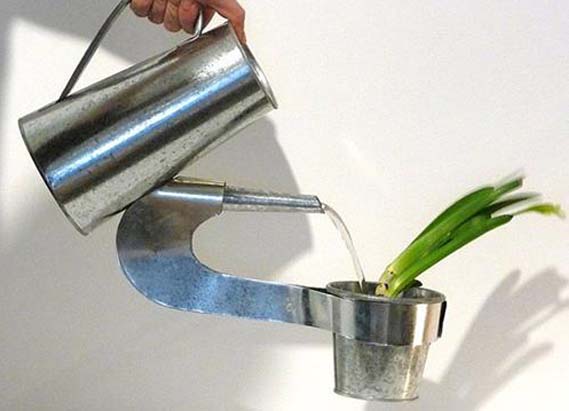
This original watering can is called Selfish & Devote and is a design by Cengiz Deger
Watering is not just watering the plants, as my mother would say, but one of the key issues for the maintenance and care of our orchard or garden. Irrigation is the sustenance of our plants, different according to the species or the time of year, and there are some recommendations that we should continue to do it correctly. In the case of the flowerpot, its importance is vital, because with the scarce soil available to our crops, its water retention and storage capacity is also limited.
We indicate the keys and irrigation methods according to the crop and the time of year.
General requirements
The optimal irrigation of our garden requires it to be:
-
Regular: If several days go by without watering, we not only make the plant suffer water stress and weaken, but we also alter the physical properties of the substrate and its quality.
-
Homogeneous: the water must moisten the entire root ball equally.
-
Frequent: abundant irrigations are not of interest, since they entail a loss of nutrients due to the washing of the substrate, therefore, since they are scarce, they have to be repeated several times a day.
-
Adjusted to other conditions such as the time of year, the type of vegetables we grow and even the irrigation method we use.
According to time of year
For Mediterranean climate or semi-arid, irrigation varies both by frequency and by the most appropriate time, depending on the season:
- In autumn, once a day and at dawn, to avoid the risk of frost.
- In winter, once a week, and at dawn, to avoid the risk of frost.
- In spring, once a day at sunset, so that the plant is not wet in the sunniest hours.
- In summer, twice a day and at sunset, so that the plant is not wet in the sunniest hours.
According to the species
Most vegetables under normal circumstances require moderate irrigations of 1 liter per plant or per 10 l of substrate, but there are some peculiarities:
- Plants grown for their leaves, such as lettuce or chard, and more demanding plants such as endives, cabbages and cauliflowers, require copious irrigations of 2l per plant.
- Plants to be preserved after harvest, such as onions, garlic or tomatoes for storage, require scant watering of ½ l of water per plant or per 10 l of substrate.
- Plants that we grow for their fruits, in the first blooms the irrigation is more limited, being more regular when the fruits set and copious after each harvest.
According to the irrigation method
-
Manual watering with watering can. With the watering can, the water is directed little by little to the roots and not to the leaves, which we must avoid getting wet. In this way, the entire substrate is soaked, without forming cracks through which the water runs without being used by the plant. In addition, it is not advisable to water from a certain height, since the impact of the water could dislodge the plant and affect its root system.
-
Drip irrigation system. Watering is more frequent than manual. In summer, 2 or 3 times a day with at least 1 minute duration. Being shorter irrigations, the humidity is better distributed. If running water is used, in hard water areas with a large amount of carbonates, the drippers can become clogged and you will need maintenance work or the installation of a filter together with the pressure regulator.
-
Planters with irrigation tank. They are called hydromassages. This type of container with self-irrigation allows greater independence with respect to irrigation, since its frequency is 1 to 3 times a week.
Source: planethuerto.es
